BMW X5 3.0I 2001 Owners Manual
Manufacturer: BMW, Model Year: 2001, Model line: X5 3.0I, Model: BMW X5 3.0I 2001Pages: 223, PDF Size: 2.66 MB
Page 191 of 223
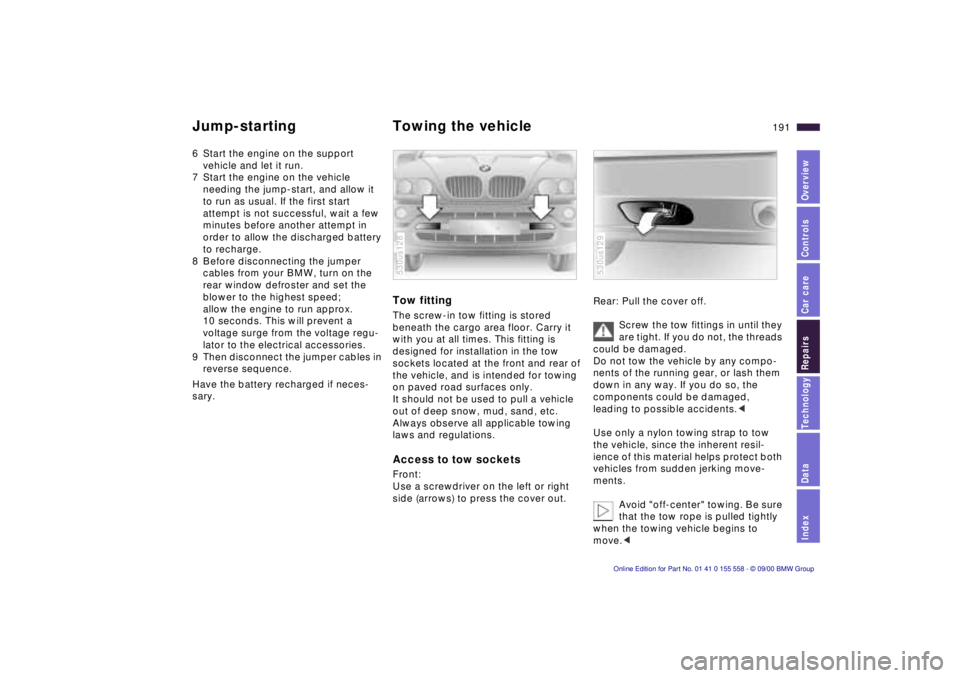
IndexDataTechnologyRepairsCar careControlsOverview
191n
Jump-starting Towing the vehicle 6 Start the engine on the support
vehicle and let it run.
7 Start the engine on the vehicle
needing the jump-start, and allow it
to run as usual. If the first start
attempt is not successful, wait a few
minutes before another attempt in
order to allow the discharged battery
to recharge.
8 Before disconnecting the jumper
cables from your BMW, turn on the
rear window defroster and set the
blower to the highest speed;
allow the engine to run approx.
10 seconds. This will prevent a
voltage surge from the voltage regu-
lator to the electrical accessories.
9 Then disconnect the jumper cables in
reverse sequence.
Have the battery recharged if neces-
sary.
Tow fitting The screw-in tow fitting is stored
beneath the cargo area floor. Carry it
with you at all times. This fitting is
designed for installation in the tow
sockets located at the front and rear of
the vehicle, and is intended for towing
on paved road surfaces only.
It should not be used to pull a vehicle
out of deep snow, mud, sand, etc.
Always observe all applicable towing
laws and regulations. Access to tow sockets Front:
Use a screwdriver on the left or right
side (arrows) to press the cover out. 530us128
Rear: Pull the cover off.
Screw the tow fittings in until they
are tight. If you do not, the threads
could be damaged.
Do not tow the vehicle by any compo-
nents of the running gear, or lash them
down in any way. If you do so, the
components could be damaged,
leading to possible accidents.<
Use only a nylon towing strap to tow
the vehicle, since the inherent resil-
ience of this material helps protect both
vehicles from sudden jerking move-
ments.
Avoid "off-center" towing. Be sure
that the tow rope is pulled tightly
when the towing vehicle begins to
move.< 530us129
Page 192 of 223
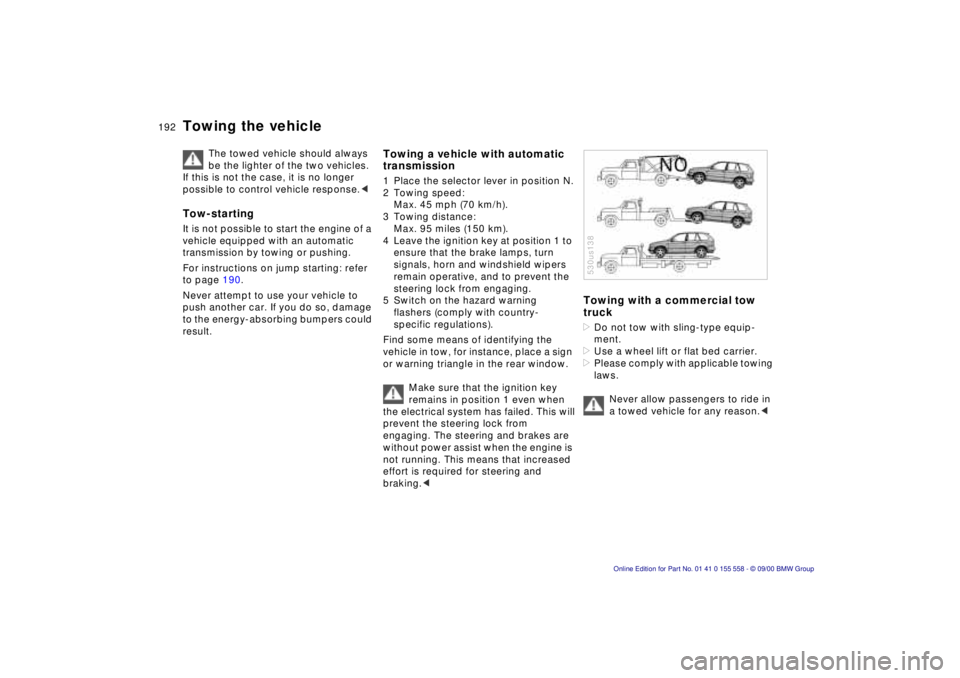
192n
Towing the vehicle
The towed vehicle should always
be the lighter of the two vehicles.
If this is not the case, it is no longer
possible to control vehicle response.<
Tow-starting It is not possible to start the engine of a
vehicle equipped with an automatic
transmission by towing or pushing.
For instructions on jump starting: refer
to page 190.
Never attempt to use your vehicle to
push another car. If you do so, damage
to the energy-absorbing bumpers could
result.
Towing a vehicle with automatic
transmission1 Place the selector lever in position N.
2 Towing speed:
Max. 45 mph (70 km/h).
3 Towing distance:
Max. 95 miles (150 km).
4 Leave the ignition key at position 1 to
ensure that the brake lamps, turn
signals, horn and windshield wipers
remain operative, and to prevent the
steering lock from engaging.
5 Switch on the hazard warning
flashers (comply with country-
specific regulations).
Find some means of identifying the
vehicle in tow, for instance, place a sign
or warning triangle in the rear window.
Make sure that the ignition key
remains in position 1 even when
the electrical system has failed. This will
prevent the steering lock from
engaging. The steering and brakes are
without power assist when the engine is
not running. This means that increased
effort is required for steering and
braking.<
Towing with a commercial tow
truck>Do not tow with sling-type equip-
ment.
>Use a wheel lift or flat bed carrier.
>Please comply with applicable towing
laws.
Never allow passengers to ride in
a towed vehicle for any reason.< 530us138
Page 193 of 223
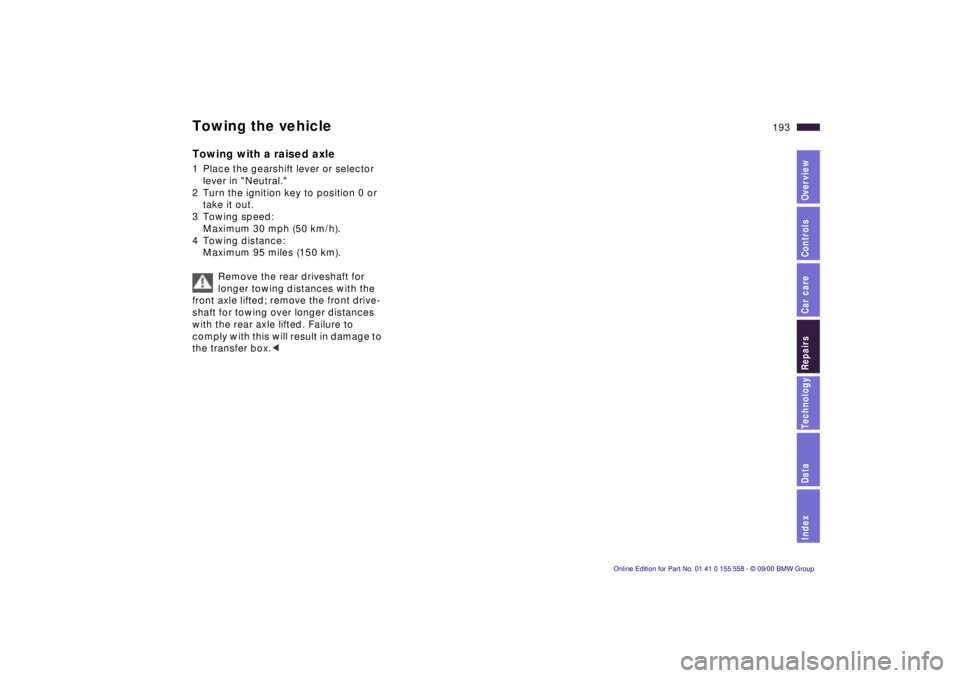
IndexDataTechnologyRepairsCar careControlsOverview
193n
Towing the vehicleTowing with a raised axle1 Place the gearshift lever or selector
lever in "Neutral."
2 Turn the ignition key to position 0 or
take it out.
3 Towing speed:
Maximum 30 mph (50 km/h).
4 Towing distance:
Maximum 95 miles (150 km).
Remove the rear driveshaft for
longer towing distances with the
front axle lifted; remove the front drive-
shaft for towing over longer distances
with the rear axle lifted. Failure to
comply with this will result in damage to
the transfer box.<
Page 194 of 223
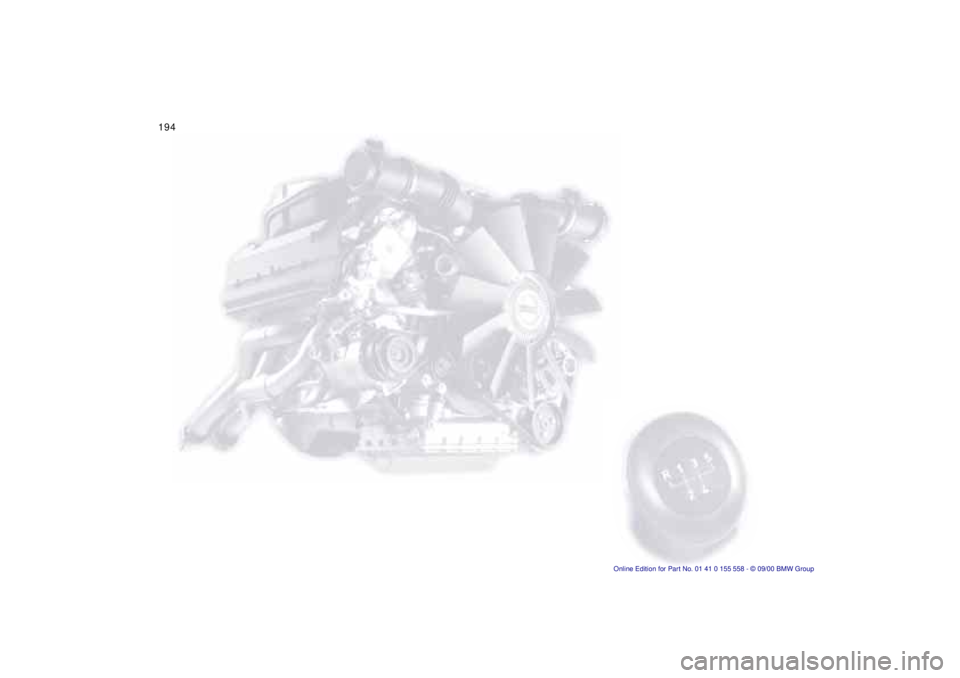
194n
Page 195 of 223
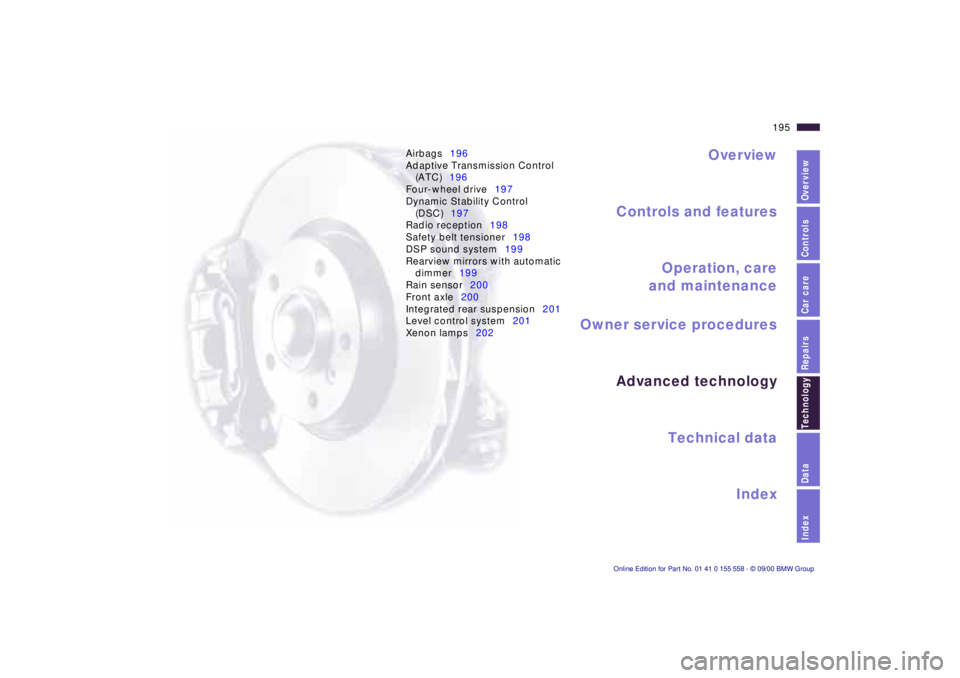
IndexDataTechnologyRepairsCar careControlsOverview
Overview
Controls and features
Operation, care
and maintenance
Owner service procedures
Technical data
Index Advanced technology
195n
Airbags196
Adaptive Transmission Control
(ATC)196
Four-wheel drive197
Dynamic Stability Control
(DSC)197
Radio reception198
Safety belt tensioner198
DSP sound system199
Rearview mirrors with automatic
dimmer199
Rain sensor200
Front axle200
Integrated rear suspension201
Level control system201
Xenon lamps202
Technology
Page 196 of 223
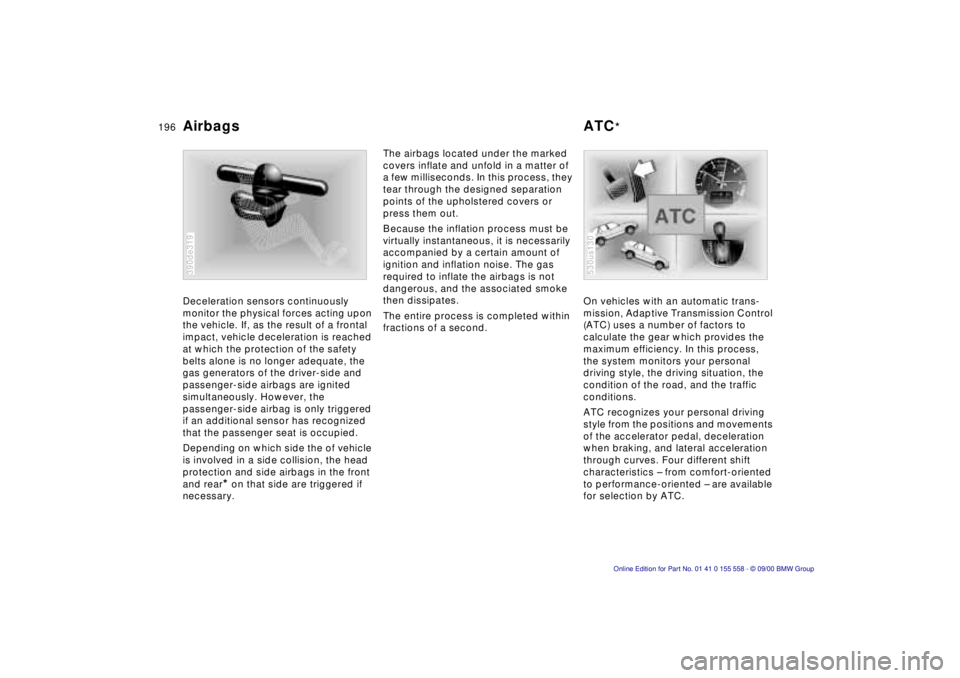
196n
Deceleration sensors continuously
monitor the physical forces acting upon
the vehicle. If, as the result of a frontal
impact, vehicle deceleration is reached
at which the protection of the safety
belts alone is no longer adequate, the
gas generators of the driver-side and
passenger-side airbags are ignited
simultaneously. However, the
passenger-side airbag is only triggered
if an additional sensor has recognized
that the passenger seat is occupied.
Depending on which side the of vehicle
is involved in a side collision, the head
protection and side airbags in the front
and rear
* on that side are triggered if
necessary.
390de319
The airbags located under the marked
covers inflate and unfold in a matter of
a few milliseconds. In this process, they
tear through the designed separation
points of the upholstered covers or
press them out.
Because the inflation process must be
virtually instantaneous, it is necessarily
accompanied by a certain amount of
ignition and inflation noise. The gas
required to inflate the airbags is not
dangerous, and the associated smoke
then dissipates.
The entire process is completed within
fractions of a second. On vehicles with an automatic trans-
mission, Adaptive Transmission Control
(ATC) uses a number of factors to
calculate the gear which provides the
maximum efficiency. In this process,
the system monitors your personal
driving style, the driving situation, the
condition of the road, and the traffic
conditions.
ATC recognizes your personal driving
style from the positions and movements
of the accelerator pedal, deceleration
when braking, and lateral acceleration
through curves. Four different shift
characteristics – from comfort-oriented
to performance-oriented – are available
for selection by ATC.
530us130
Airbags ATC
*
Page 197 of 223
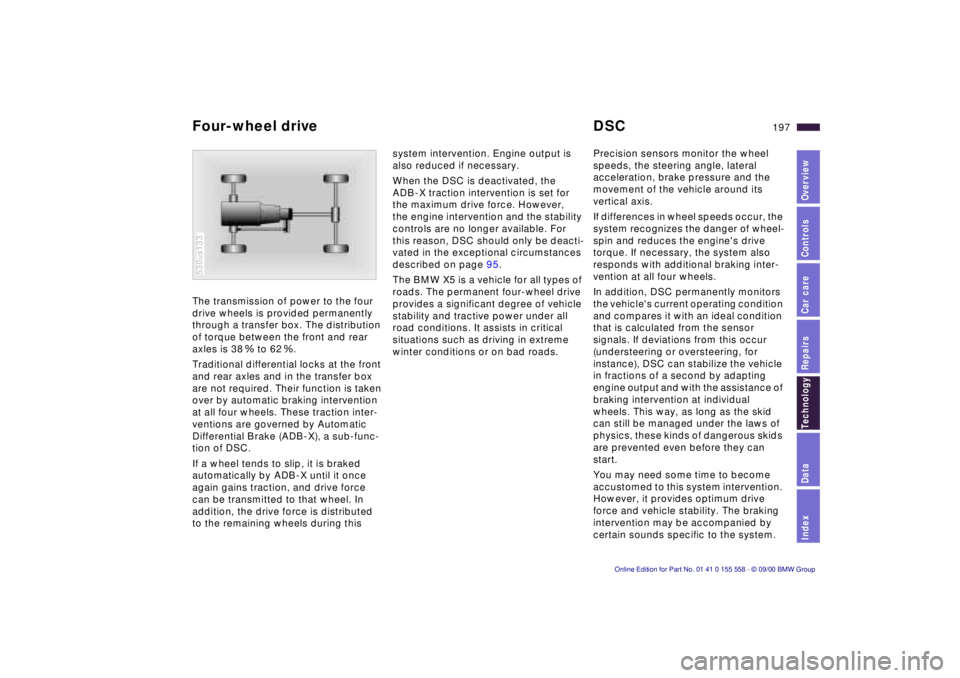
IndexDataTechnologyRepairsCar careControlsOverview
197n
The transmission of power to the four
drive wheels is provided permanently
through a transfer box. The distribution
of torque between the front and rear
axles is 38% to 62%.
Traditional differential locks at the front
and rear axles and in the transfer box
are not required. Their function is taken
over by automatic braking intervention
at all four wheels. These traction inter-
ventions are governed by Automatic
Differential Brake (ADB-X), a sub-func-
tion of DSC.
If a wheel tends to slip, it is braked
automatically by ADB-X until it once
again gains traction, and drive force
can be transmitted to that wheel. In
addition, the drive force is distributed
to the remaining wheels during this
530us133
system intervention. Engine output is
also reduced if necessary.
When the DSC is deactivated, the
ADB-X traction intervention is set for
the maximum drive force. However,
the engine intervention and the stability
controls are no longer available. For
this reason, DSC should only be deacti-
vated in the exceptional circumstances
described on page 95.
The BMW X5 is a vehicle for all types of
roads. The permanent four-wheel drive
provides a significant degree of vehicle
stability and tractive power under all
road conditions. It assists in critical
situations such as driving in extreme
winter conditions or on bad roads. Precision sensors monitor the wheel
speeds, the steering angle, lateral
acceleration, brake pressure and the
movement of the vehicle around its
vertical axis.
If differences in wheel speeds occur, the
system recognizes the danger of wheel-
spin and reduces the engine's drive
torque. If necessary, the system also
responds with additional braking inter-
vention at all four wheels.
In addition, DSC permanently monitors
the vehicle's current operating condition
and compares it with an ideal condition
that is calculated from the sensor
signals. If deviations from this occur
(understeering or oversteering, for
instance), DSC can stabilize the vehicle
in fractions of a second by adapting
engine output and with the assistance of
braking intervention at individual
wheels. This way, as long as the skid
can still be managed under the laws of
physics, these kinds of dangerous skids
are prevented even before they can
start.
You may need some time to become
accustomed to this system intervention.
However, it provides optimum drive
force and vehicle stability. The braking
intervention may be accompanied by
certain sounds specific to the system.
Four-wheel drive DSC
Page 198 of 223
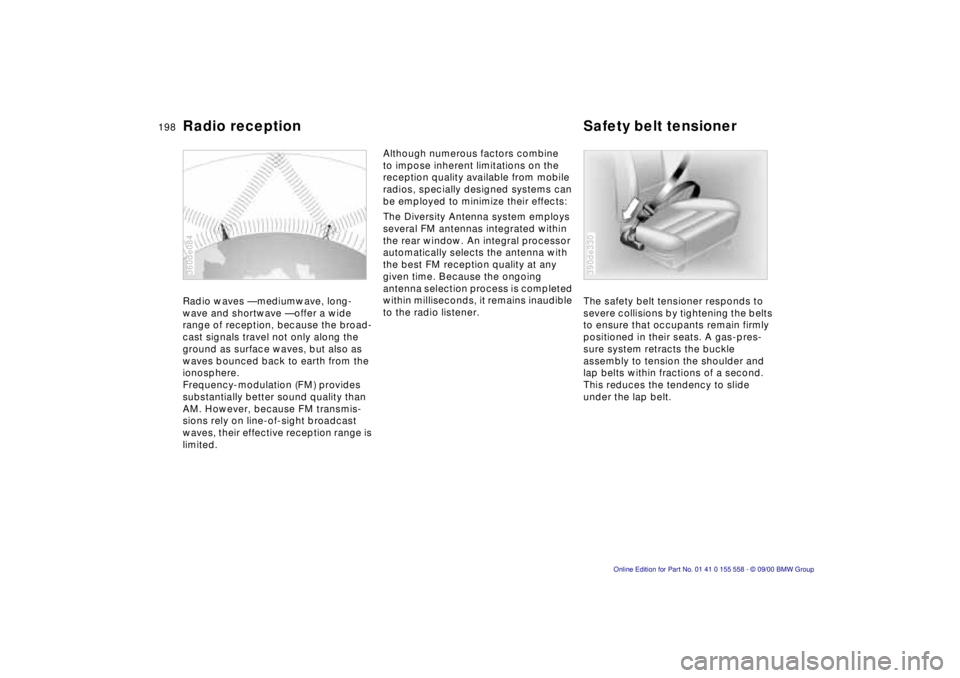
198nRadio reception Safety belt tensioner
Radio waves — mediumwave, long-
wave and shortwave — offer a wide
range of reception, because the broad-
cast signals travel not only along the
ground as surface waves, but also as
waves bounced back to earth from the
ionosphere.
Frequency-modulation (FM) provides
substantially better sound quality than
AM. However, because FM transmis-
sions rely on line-of-sight broadcast
waves, their effective reception range is
limited.
360de084
Although numerous factors combine
to impose inherent limitations on the
reception quality available from mobile
radios, specially designed systems can
be employed to minimize their effects:
The Diversity Antenna system employs
several FM antennas integrated within
the rear window. An integral processor
automatically selects the antenna with
the best FM reception quality at any
given time. Because the ongoing
antenna selection process is completed
within milliseconds, it remains inaudible
to the radio listener. The safety belt tensioner responds to
severe collisions by tightening the belts
to ensure that occupants remain firmly
positioned in their seats. A gas-pres-
sure system retracts the buckle
assembly to tension the shoulder and
lap belts within fractions of a second.
This reduces the tendency to slide
under the lap belt.
390de330
Page 199 of 223
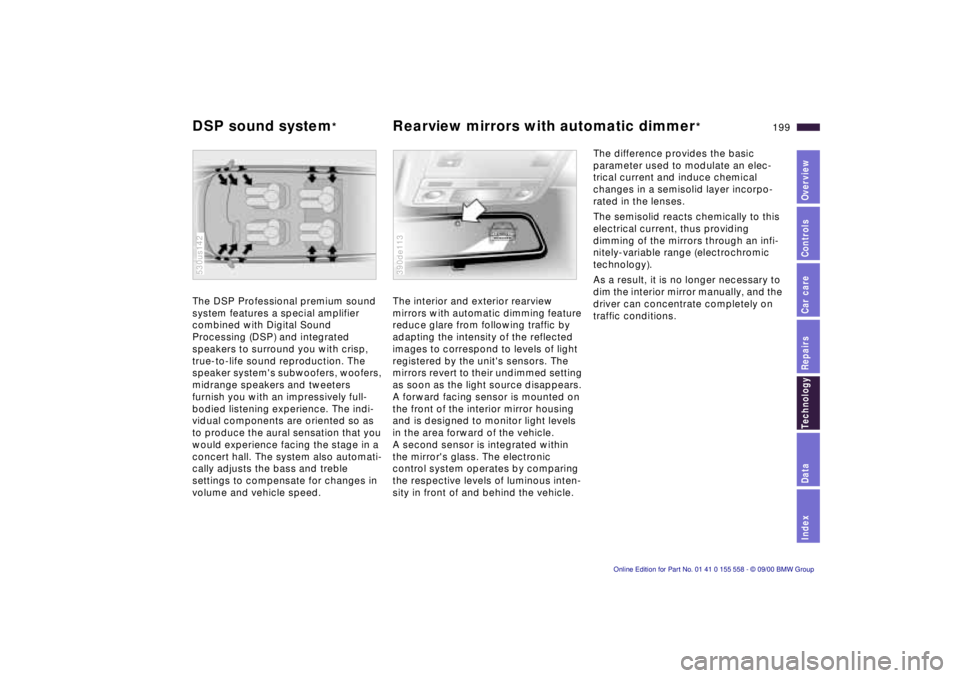
Index
Data
Technology
Repairs
Car care
Controls
Overview
199nDSP sound system* Rearview mirrors with automatic dimmer*
The DSP Professional premium sound
system features a special amplifier
combined with Digital Sound
Processing (DSP) and integrated
speakers to surround you with crisp,
true-to-life sound reproduction. The
speaker system's subwoofers, woofers,
midrange speakers and tweeters
furnish you with an impressively full-
bodied listening experience. The indi-
vidual components are oriented so as
to produce the aural sensation that you
would experience facing the stage in a
concert hall. The system also automati-
cally adjusts the bass and treble
settings to compensate for changes in
volume and vehicle speed.
530us142
The interior and exterior rearview
mirrors with automatic dimming feature
reduce glare from following traffic by
adapting the intensity of the reflected
images to correspond to levels of light
registered by the unit's sensors. The
mirrors revert to their undimmed setting
as soon as the light source disappears.
A forward facing sensor is mounted on
the front of the interior mirror housing
and is designed to monitor light levels
in the area forward of the vehicle.
A second sensor is integrated within
the mirror's glass. The electronic
control system operates by comparing
the respective levels of luminous inten-
sity in front of and behind the vehicle.
390de113
The difference provides the basic
parameter used to modulate an elec-
trical current and induce chemical
changes in a semisolid layer incorpo-
rated in the lenses.
The semisolid reacts chemically to this
electrical current, thus providing
dimming of the mirrors through an infi-
nitely-variable range (electrochromic
technology).
As a result, it is no longer necessary to
dim the interior mirror manually, and the
driver can concentrate completely on
traffic conditions.
Page 200 of 223
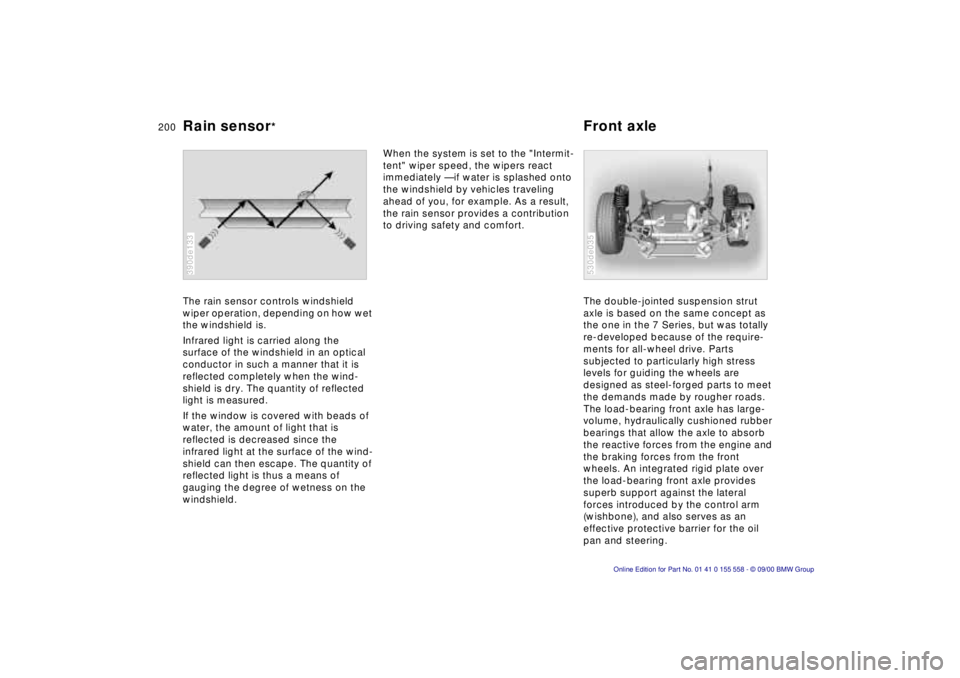
200nRain sensor* Front axle
The rain sensor controls windshield
wiper operation, depending on how wet
the windshield is.
Infrared light is carried along the
surface of the windshield in an optical
conductor in such a manner that it is
reflected completely when the wind-
shield is dry. The quantity of reflected
light is measured.
If the window is covered with beads of
water, the amount of light that is
reflected is decreased since the
infrared light at the surface of the wind-
shield can then escape. The quantity of
reflected light is thus a means of
gauging the degree of wetness on the
windshield.
390de133
When the system is set to the "Intermit-
tent" wiper speed, the wipers react
immediately — if water is splashed onto
the windshield by vehicles traveling
ahead of you, for example. As a result,
the rain sensor provides a contribution
to driving safety and comfort.
The double-jointed suspension strut
axle is based on the same concept as
the one in the 7 Series, but was totally
re-developed because of the require-
ments for all-wheel drive. Parts
subjected to particularly high stress
levels for guiding the wheels are
designed as steel-forged parts to meet
the demands made by rougher roads.
The load-bearing front axle has large-
volume, hydraulically cushioned rubber
bearings that allow the axle to absorb
the reactive forces from the engine and
the braking forces from the front
wheels. An integrated rigid plate over
the load-bearing front axle provides
superb support against the lateral
forces introduced by the control arm
(wishbone), and also serves as an
effective protective barrier for the oil
pan and steering.
530de035